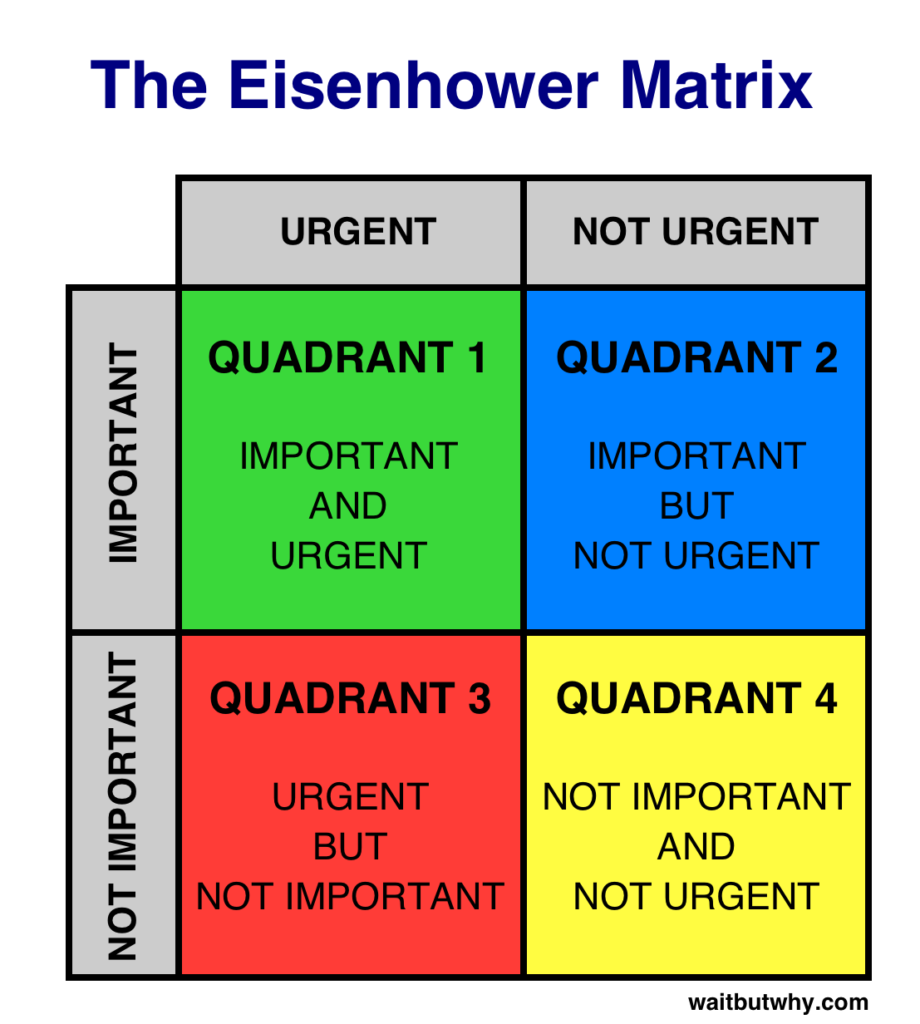Urgency as a noun is defined as “importance requiring swift action” or “insistence/persistence”. Seeing what’s happening in Ukraine in real time shows us a situation that is urgent and important.
A friend recently mentioned the “Eisenhower Decision Matrix” or the “Eisenhower Decision Principle”. It’s been years since I’ve reviewed this! It applies to so many situations that today seemed like a good time to resurface it.
Urgent vs. Important
Urgent means that a task requires immediate attention. These are the to-do’s that shout “Look At Me Now!” Urgent tasks put us in a reactive mode.
Important tasks are things that contribute to our long-term mission, values, goals, and wellbeing. Sometimes important tasks are also urgent. When we focus on important activities we operate in a responsive mode, which helps us maintain calm and resolve when we need it.
It’s a pretty intuitive distinction, yet often we find it easy to fall into the trap of believing that all urgent activities are also important. Recognizing the difference between short-term concerns and long-term strategy invites you to stretch differently.
Modern technologies (24-hour news, Social Media, and messaging) constantly bombard us with information. Our stimulus-producing tech time seems to treat all information as equally urgent and pressing. In reality, there is a difference between a tweet and important world events, yet because of the way the information comes at us, it may seem as if the two are the same.
Author Douglas Rushkoff wrote about “present shock” – a condition in which “we live in a continuous, always-on ‘now’ and lose our sense of long-term narrative and direction. In such a state, it is easy to lose sight of the distinction between the truly important and the merely urgent. Keep this in mind while processing information.
The Eisenhower Decision Matrix
Stephen Covey popularized the Eisenhower’s Decision Principle in his book, The 7 Habits of Highly Effective People. Covey created a decision matrix to help individuals make the distinction between what’s important and not important and what’s urgent and not urgent. The matrix consists of a square divided into four boxes, or quadrants, labeled thusly: 1) Urgent/Important, 2) Not Urgent/Important, 3) Urgent/Not Important, and 4) Not Urgent/Not Important.
Let’s dig in a little deeper to understand these quadrants in general and how they may apply for you.

Quadrant 1: Urgent and Important Tasks
Quadrant 1 tasks are both urgent and important. They’re tasks that require our immediate attention and also work towards fulfilling our long-term goals. Quadrant 1 tasks typically consist of crises, problems, or deadlines. Here are a few specific examples of Urgent and Important tasks:
- Certain emails (could be a job offer, an email for a new business opportunity that requires immediate action, etc.)
- Tax deadlines
- Family member in emergency room
- Natural disaster warning in your area
With a bit of planning and organization, many Quadrant 1 tasks can be made more efficient or even eliminated outright. For example, instead of waiting until the last minute to prepare for an evacuation warning (thus turning it into an urgent task), you could schedule your time over the course of a month to prepare supplies, important documents, etc. Or instead of waiting for the tax deadline to arrive, you could maintain records and receipts throughout the year.
While we’ll never be able to completely eliminate urgent and important tasks, we can significantly reduce them with a bit of proactivity and by spending more time in Quadrant 2.
Quadrant 2: Not Urgent but Important Tasks
Quadrant 2 tasks are the activities that don’t have a pressing deadline, but nonetheless help you achieve your important personal, work, and life goals. Q2 tasks are typically centered around relationships, planning for the future, and overall wellbeing. Here are some specific examples of Not Urgent but Important Tasks:
- Long-term and short-term planning
- What-if situational planning
- Protection strategies
- Generational planning
- Health, Financial and legal planning
According to Covey, we should seek to spend most of our time on Q2 activities, as they provide us lasting happiness, fulfillment, and success. It’s important to pay attention to what keeps you from investing enough time and energy into Q2 tasks.
Because Q2 activities aren’t pressing for your attention, it is easy to keep them forever on the backburner of your life and tell yourself, “I’ll get to those things ‘someday’ after I’ve taken care of this urgent stuff.” We even put off figuring out what’s most important in life, which can result in only the most urgent to-dos on your list are the only things done.
It may help to familiarize yourself with the term “present bias”. Present bias is when you focus on what’s most pressing in the moment. It can be more difficult to motivate to take action without a deadline.
Quadrant 3: Urgent and Not Important Tasks
Quadrant 3 tasks are activities that require your attention now (urgent), but don’t help achieve your goals (not important). Most Q3 tasks are interruptions from other people and often involve helping them meet their own goals and fulfill their own priorities. Here are some specific examples of Quadrant 3 activities:
- Phone calls
- Text messages
- Most emails (some emails could be urgent and important)
- Co-worker who comes by your desk
- Family interruptions during work hours while you’re on a Zoom call
According to Covey, many spend most of their time on Q3 tasks, thinking they’re working in Q1. Because Q3 tasks do help others, they feel important. And often they are tangible tasks, and when completed give you a sense of satisfaction that comes from checking something off your list.
But while Q3 tasks may be important to others, they’re not important to you. It’s important they are balanced with your Q2 activities. Otherwise, there is the potential you’ll feel like you’re accomplishing big things and you realize progress hasn’t been made toward your goals.
Quadrant 4: Not Urgent and Not Important Tasks
Quadrant 4 activities aren’t urgent and aren’t important. They’re primarily “mindless activities”. Specific examples of Not Urgent and Not Important Tasks include:
- Watching TV
- Mindlessly surfing the web
- Playing video games
- Scrolling through Facebook, Twitter, Instagram
- Shopping sprees
Mindless activities can be a break from the stresses of day to day life. Pay attention to how much time “invested” here and consider what the options are to de-stress and feel more productive if you’re concerned about spending too much time in mindless activities.

Invest Time on Important Tasks
In our present day world, the ability to filter from all the noise, or distinguish between what’s urgent and what’s truly important, is an essential skill to have. When faced with a decision, stop and ask yourself, “Am I doing this because it’s important or am I doing it because it’s merely urgent?”
Pay attention as you spend most of your time working on Not Urgent but Important tasks. Knowing you’re investing on the important tasks can bring you a renewed sense of calm, control, and composure in your life. You’ll feel like you’re making real progress.
When you invest time in Quadrant 2’s planning/organizing activities, you can prevent and eliminate many of the crises and problems of Quadrant 1, balance the requests of Quadrant 3 with your own needs, and truly enjoy the mindless activities of Quadrant 4, knowing that you’ve earned the rest. By making Quadrant 2 tasks your top priority, no matter the emergency, annoyance, or deadline you’re hit with, you’ll have the mental, emotional, and physical wherewithal to respond vs. react.
Your Wellbeing Matters
The Wellbeing Checkup was created to help people focus on the important planning/organizing activities at home and work. Think about it, emergency situations are never easy. Creating a roadmap for you based upon your situation is a way to eliminate the crises and problems of Quadrant 1. Here is a link to check it out: https://bit.ly/WBCheckup
Reach out anytime by email: Lynn@thelivingplanner.com and/or check out all my online offerings, resources, and information focused on People, Pets and Business here: https://bit.ly/LPCourses
To Planning and Organizing –Lynn
#CareForPeopleCareForBusiness
